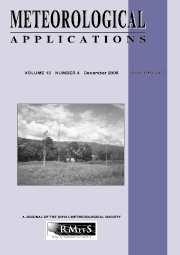Article contents
The Storm-Structure-Severity method for the identification of convective storm characteristics with conventional weather radar
Published online by Cambridge University Press: 18 April 2001
Abstract
Radar reflectivity information is often displayed in two dimensions, makingit difficult to extract the structural characteristics of convectivestorms. The maximum radar reflectivity and the vertical profile of liquidwater distribution in a vertical column of a convective cell is used todetermine a structural and intensity classification of the cell. Theapplication of this Storm-Structure-Severity classification is demonstratedby investigating a tornado event on 15 November 1998 in Harrismith, SouthAfrica, by using volume-scanned reflectivity data from the S-band MRL-5radar. The regions of convective development, decay and mesocycloneevolution are identified with this classification. The method is ableto extract the three-dimensional structural information of convectivestorms embedded in volume-scanned reflectivity data and present it ina simple display format.
Information
- Type
- Research Article
- Information
- Copyright
- © 2001 Royal Meterological Society
- 4
- Cited by

